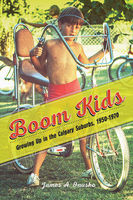James A. Onusko on the Complex Legacy of the Baby Boomers' Suburban Youths
Both urban and rural settings abound in literature, but the manufactured homogeneity of suburban areas is less frequently deemed worthy of literary exploration. Academic James A. Onusko challenges that in his nonfiction examination of suburban childhood, Boom Kids: Growing Up in the Calgary Suburbs, 1950-1970 (Wilfrid Laurier University Press). Onusko digs into the legacy that postwar suburbia created in Canada as the country found itself rapidly changing to conform to the new aspirations of Baby Boomers—children and young adults growing up in a world unrecognizable to previous generations.
Challenging the notion that postwar suburbia represented only either an unsullied Eden or a flattened cultural absence, Onusko examines young people's complex relationships to sexuality, race, the body, play, the Cold War, and more, all through the lens of suburban living. In a world still shaped by the legacy of Baby Boomers' young adult years, it is fascinating to delve into the period of rapid change that moulded one of the most influential generations in modern history.
We're pleased to welcome James to Open Book today to discuss Boom Kids as part of our True Story nonfiction interview series. He tells us what it is like being a scholar focused on the study of childhood, what surprised him most during his research process for Boom Kids, and how long runs help him work through difficult points in the writing process.
Open Book:
Tell us about your new book and how it came to be. What made you passionate about the subject matter you're exploring?
James A. Onusko:
Boom Kids is based on my Trent University PhD dissertation. My primary scholarly area of expertise is the history of childhood. Canadian childhoods, have not been explored to the same depth as most other sub-fields in Canadian history. Addressing the marginalization, silencing, and relative invisibility of children as historical subjects is something that I am very passionate about. In particular, I was expressly interested in looking at Cold War-era suburbia through the lens of childhood and children – something relatively unexplored. The oral histories allowed me to look at several themes in a unique way and truly fuelled my ongoing interest in postwar childhoods. Finally, I wanted to focus on an Alberta-based suburb. Suburban history in Canada has been focused nearly exclusively on Central Canada so I was both curious and excited to shift this to the Prairies. Calgary moved from its metaphorical childhood to adolescence in these 20 years, so this dovetailed well with my main focus on children and adolescents.
OB:
Is there a question that is central to your book? And if so, is it the same question you were thinking about when you started writing or did it change during the writing process?
JAO:
The central inquiry is: How did children and adolescents impact postwar suburbia and conversely, how did this influential built environment impact children and childhood in the 1950s and 1960s? Yes, this central question, remained unchanged as I researched, reflected, and wrote. Several other questions emerged during the writing process. I responded to some of these in the book, while others are filed for future work.
OB:
What was your research process like for this book? Did you encounter anything unexpected while you were researching?
JAO:
The process was enjoyable, though taxing, without question. The ability to speak to baby boomers about their childhoods was rewarding on many levels. The inherent generosity that they offered, collectively, was a highlight. Oral history is always challenging to undertake, and there is no question that I improved my skills during the research process, but the challenge is what made it so rewarding. I learned so much about these interviewees on a personal level, and then to be able to identify patterns that connected them to other community members, Calgarians, and ultimately, other youngsters in Canada and the United States, was rewarding. The scripts that emerged from these interviews, were then enriched by the primary documents associated with young people that I was able to access. Many of these documents had been untouched since the 1940s through 1970s. In many instances, these documents were created by children and adolescents, so in many ways, I trust that readers will get a real sense of this period from the perspective of these young people – and potentially view the era in a new way. I also consulted with thousands of other primary documents, alongside dozens of secondary sources related to my major topics and themes. There were so many unexpected things that emerged during my research. I cannot even begin to detail all of them, but I think one major takeaway, expressed in both the oral histories, and in the written record, was the vibrancy of this cohort. While the adage of children being “seen and not heard” was still prevalent in many contexts for young people, they had so much to say about themselves, their friends, their families, their schools, and their wider community – through memories of childhood and in the remaining written record. It made me reflect on what other hidden histories remain untold – which should be exciting for all historians of childhood.
OB:
What do you do if you're feeling discouraged during the writing process? Do you have a method of coping with the difficult points in your projects?
Your CanLit News
Subscribe to Open Book’s newsletter to get local book events, literary content, writing tips, and more in your inbox
JAO:
I have had many discouraging moments while writing. There were times, especially when writing Boom Kids, where I forced things. I set daily or weekly writing goals – either time- or word count-based that I thought would help me during some particularly challenging times. While this worked on occasion, generally, with any writing piece, regardless of length, I must leave it alone when there is limited flow. Sometimes that needs to be for only a few hours; at other turns, I have stayed away from it for days. I run on most days, typically early in the morning, and oftentimes, on the longer runs, I am struck by flashes of creativity. Oftentimes, I have come in quickly from a run and began taking notes, or even picking up from where I was in the writing process. Forcing or scheduling things strictly, does not work well for me – I think all writers need to give themselves more of a break during the writing process.
OB:
What defines a great work of nonfiction, in your opinion? Tell us about one or two books you consider to be truly great books.
JAO:
I love to read and to be able to teach post-secondary courses that feature dozens of amazing works of fiction and textbooks, has been a privilege. Personally, nonfiction books where I learn something new, that challenge my knowledge base, featuring lively and engaging writing, are my favourites. My list of great nonfiction books runs into the hundreds, to be honest. If I had to choose my top two, they would be Howard Zinn’s A People’s History of the United States and Alvin Finkel’s Social Policy and Practice in Canada: A History. Zinn’s book should be a must-read for everyone in North America, and maybe across the globe, for that matter. I think it is unmatched in how it shines a light on people, topics, and themes that are omitted from the majority of history books. Zinn created a narrative that forces readers to think about so much from a critical perspective. The United States remains as one of, if not the most influential nation-states in the world - this book explores that history, critically and unapologetically. I had the great fortune to have Professor Finkel serve as a mentor and supervisor during my M.A. studies at Athabasca University. His book, Social Policy and Practice is groundbreaking in how it presents the history of social policy in Canada. He asks difficult questions, and ultimately, challenges us to consider concepts of community, progress, empathy, and care. Finkel’s writing style is something that all of us should aspire to, as historians. He presents very difficult concepts in a straightforward manner which engages both specialists and general readers. This is so much easier said than done as so many nonfiction writers, especially in academia, have difficulty making their writing and research accessible; Finkel achieves this, unquestionably.
OB:
What are you working on now?
JAO:
I am co-editing a second edition of Ontario Since Confederation: A Reader from the University of Toronto Press with Professor Dimitry Anastakis. In addition to co-editing, I have written a chapter for it, “‘I had a little bird, its name was Enza,’: Children, Adolescents and the Spanish Flu.” It explores the experiences of Ontario’s young people during the devastating influenza pandemic from 1918-1920. That updated collection should be out in the next two years. I am also researching and writing a new manuscript, tentatively titled: “A Young People’s History of Canada.” It is inspired by Zinn’s work, that I mentioned earlier, along with the adapted text, A Young People’s History of the United States, that brought Zinn’s work to a broader audience. The goal with this book is twofold: highlight Canadian history through the viewfinder of young people, and to appeal to both young adult, and adult readers, alike. I’ll be seeking a publisher in the near future and hope to see it move forward soon.
__________________________________________
James A. Onusko is a permanent faculty member at Northern Lakes College. He researches the history of children and youth and post-Confederation Canadian history. He has published peer-reviewed journal articles and the public history book Ontario’s Soldiers’ Aid Commission: 100 Years of Assistance to Veterans in Need, 1915-2015.






